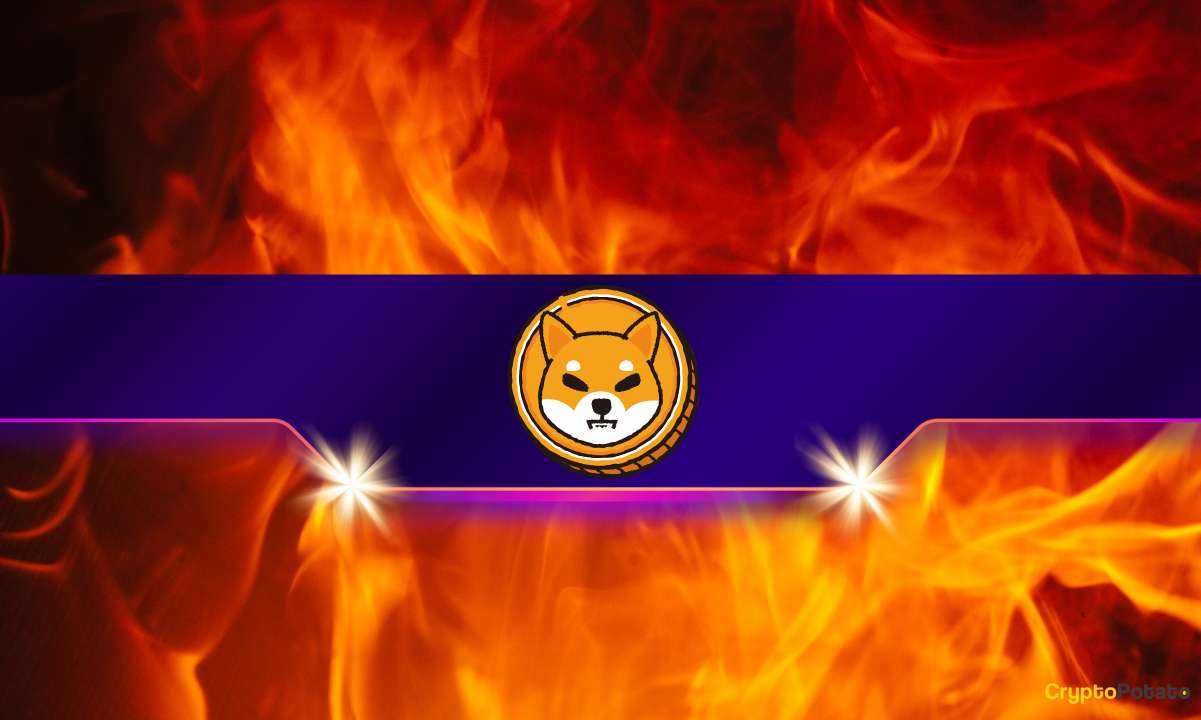The Puma medium support helicopter, one of the longest-serving aircraft in the history of the U.K. Royal Air Force (RAF), was retired by the service today, after 54 years of operations. While the workhorse helicopter was seen off in style, with farewell flights in the United Kingdom, as well as in Brunei and Cyprus, the Ministry of Defense is yet to decide on a replacement for the Puma.
At the time of its formal withdrawal today, March 31, the RAF had 23 Pumas on strength, all of which had been upgraded to the definitive HC2 standard. However, months in advance of the retirement, the main operating base at RAF Benson, England, had already begun putting Pumas into storage. The announcement that the Puma fleet would be withdrawn by the end of this month came last November, as part of sweeping cuts of the U.K. Armed Forces, as you can read about here. By that time, the frontline Puma fleet was reduced to 17 active aircraft.
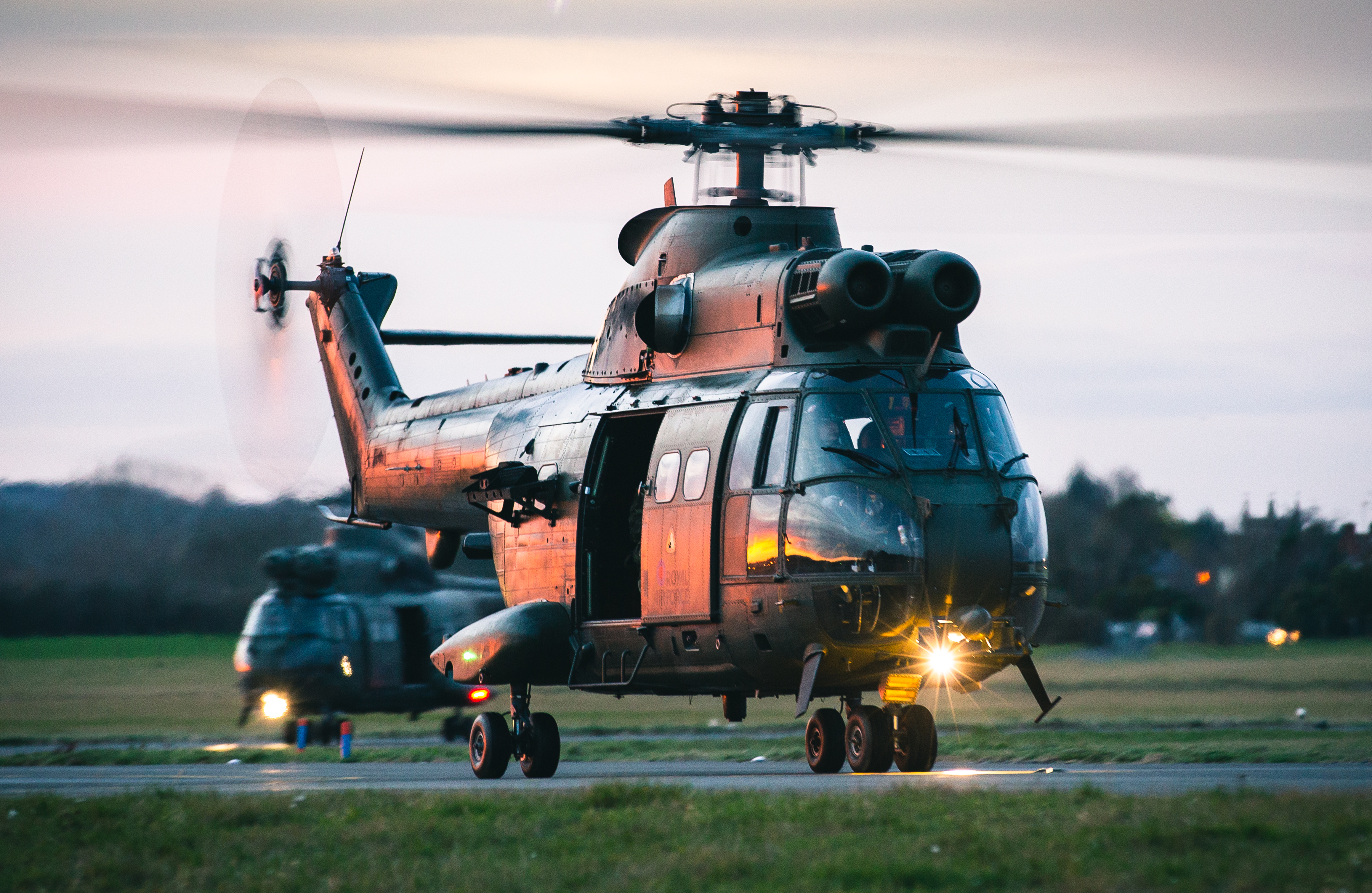 A pair of Puma H2 helicopters return home to RAF Benson after a long day supporting Exercise Wessex Storm, moving troops from 2 Para, in December 2020. Crown Copyright Sgt Andy Holmes
A pair of Puma H2 helicopters return home to RAF Benson after a long day supporting Exercise Wessex Storm, moving troops from 2 Para, in December 2020. Crown Copyright Sgt Andy HolmesAs well as the Pumas, 14 of the oldest Chinook heavy-lift helicopters used by the RAF were also slated to be removed from service.
The farewell flight by three Pumas — callsign WARLOCK flight — out of Benson on March 26 took in various locations that held an important place in the type’s RAF career.
Among them was Northern Ireland, where the Puma was heavily involved during The Troubles, providing support and transport for the British Army, as well as during subsequent peacekeeping efforts.
Key training bases and exercise areas, including Cranwell, Halton, Honington, Shawbury, and the Stanford Training Area (STANTA), were also included.
Meanwhile, Boscombe Down and Airbus Kidlington were on the itinerary, these sites having been central for the maintenance and operational upkeep of the RAF Pumas in their last years of service.
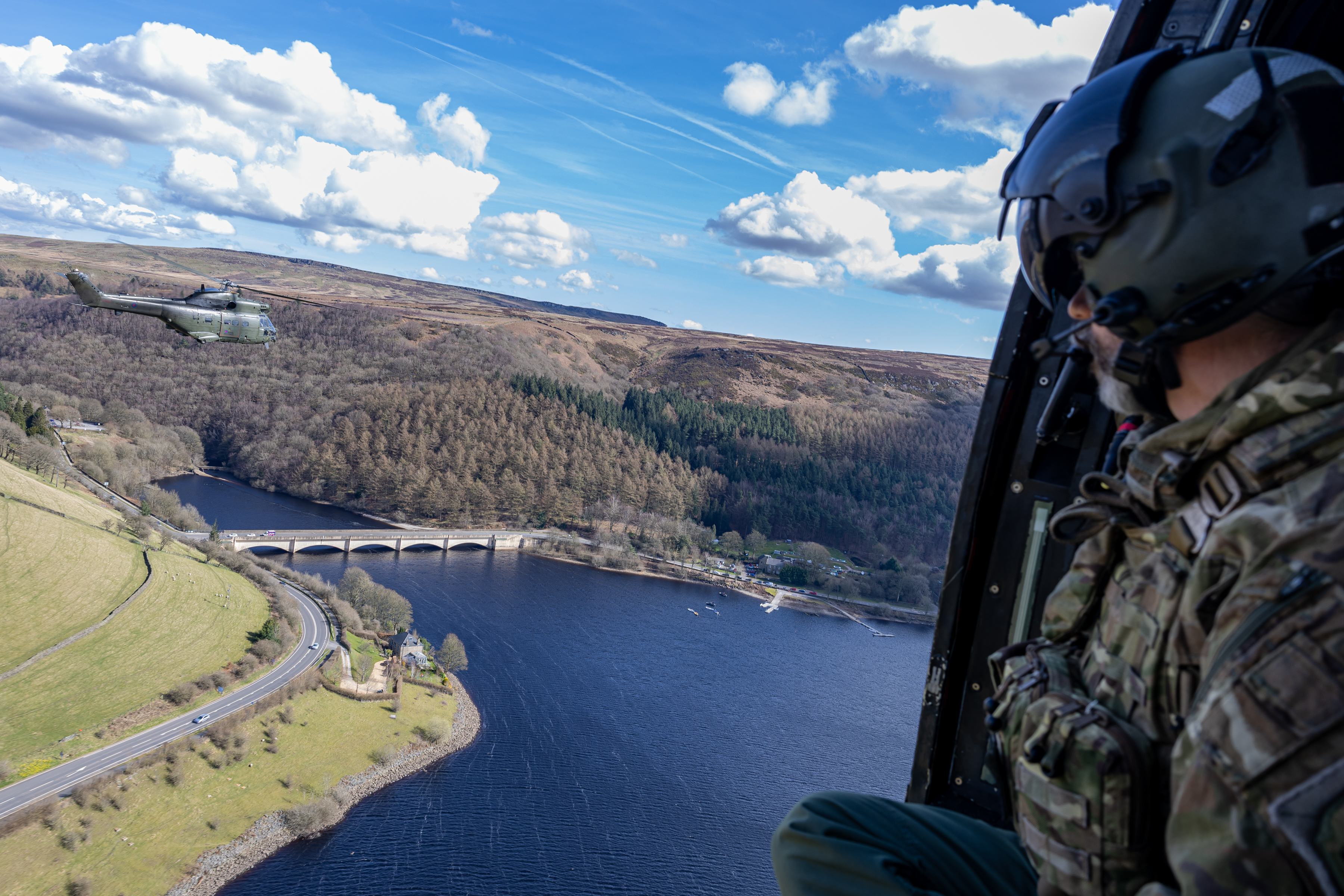 A No. 33 Squadron Puma HC2 flying over the Derwent reservoir bridge, during the final flight from RAF Benson on March 27, 2025. Crown Copyright AS1 Jake Hobbs
A No. 33 Squadron Puma HC2 flying over the Derwent reservoir bridge, during the final flight from RAF Benson on March 27, 2025. Crown Copyright AS1 Jake Hobbs“This flight route is via various locations of significance,” said Wing Commander Nick Monahan, the commanding officer of No. 33 Squadron and Puma Force Commander. “Each place reflects the rich history and contributions that the Puma has made during its time in service. The aircraft has been a cornerstone of global defense operations for more than five decades. We want to celebrate its contribution to supporting our people around the world over the past 54 years.”
Two more farewell flypasts took place at the RAF Puma’s other final operating locations: Brunei, on the island of Borneo, where the helicopter supported a battalion of the British Army’s Royal Gurkha Rifles, and Cyprus, where the type equipped the RAF’s last remaining dedicated search and rescue squadron. The Cyprus-based Pumas were also used to support British military activities on the island and for aerial firefighting.
 A No. 84 Squadron Puma HC conducts a farewell flight over Cyprus on March 27, 2025. Crown Copyright AS1 Natalie Adams RAF
A No. 84 Squadron Puma HC conducts a farewell flight over Cyprus on March 27, 2025. Crown Copyright AS1 Natalie Adams RAF
Designed by Aérospatiale of France and built in the United Kingdom by Westland, the Puma first entered RAF service in 1971. Initially, its primary mission was carrying troops and logistics, as well as casualty evacuation, which it was expected to do on the battlefield if NATO had ever gone to war with the Warsaw Pact on the Central Front.
The Puma could carry 12 fully equipped troops or up to 4,400 pounds of freight, the latter moved as internal cargo or underslung, or a mix of the two. For casualty evacuation, it could be configured with up to six stretchers.
The helicopter soon gained a reputation for agility, speed, and versatility during the course of multiple overseas operations and humanitarian relief missions. As well as in Northern Ireland and Belize, the RAF Puma saw notable operational service in Rhodesia, in the 1991 and 2003 conflicts in Iraq, and in the former Yugoslavia, where it contributed to the U.K. effort as part of the NATO-led Kosovo Force (KFOR).
Of the 48 original Puma HC1 variants, 24 were upgraded to HC2 standard, one of these being lost on operations in Afghanistan. The Puma HC2 featured more powerful Makila 1A1 turboshaft engines, increased range, new composite tail rotor blades, and a modern digital cockpit, among other changes, collectively known as the Puma Life Extension Programme (LEP).
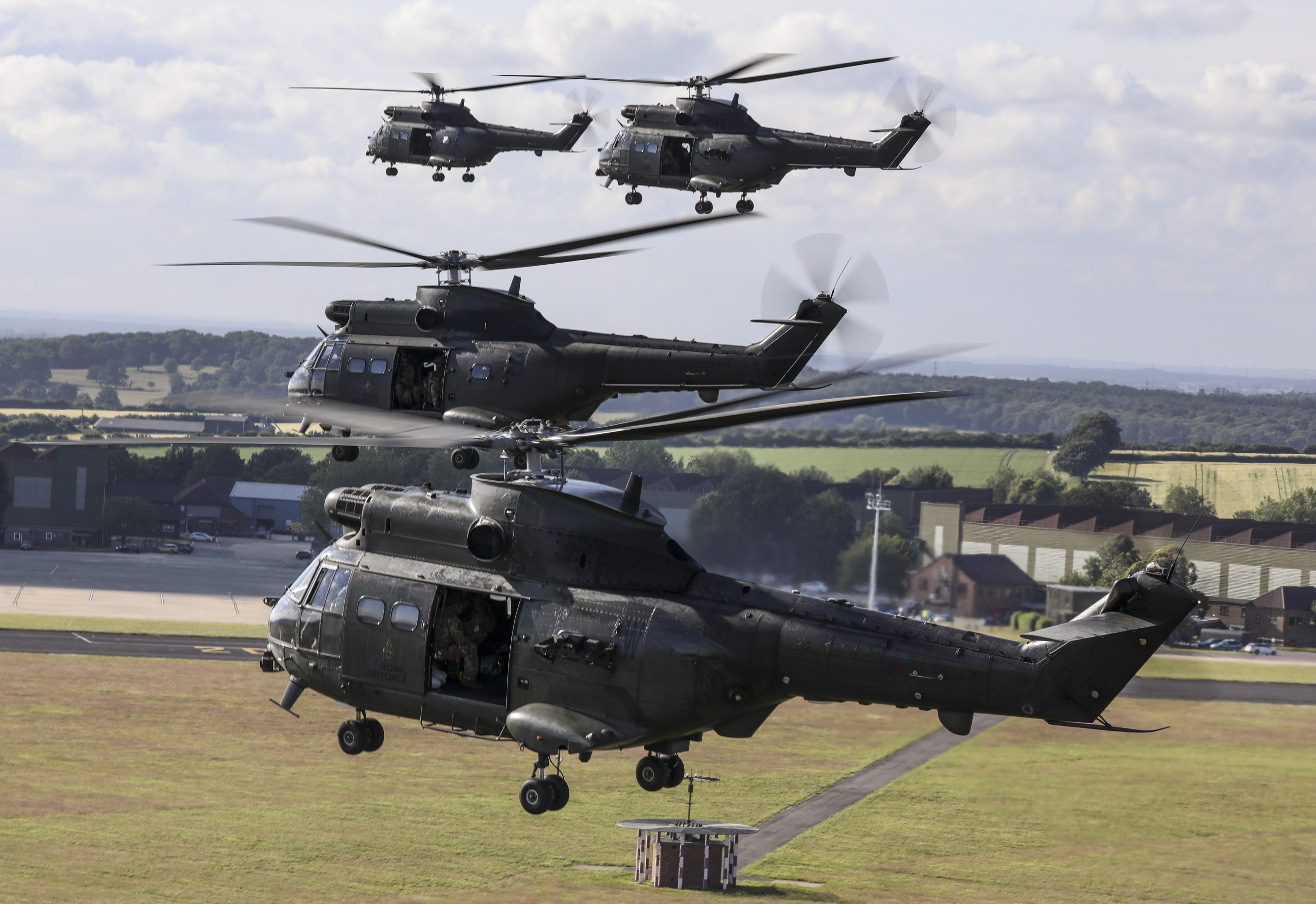 A formation of 10 Puma HC2s departs RAF Benson in July 2021 as part of a training sortie. Crown Copyright SAC Emma Wade
A formation of 10 Puma HC2s departs RAF Benson in July 2021 as part of a training sortie. Crown Copyright SAC Emma WadeThe first upgraded Puma HC2s entered RAF service in September 2012, followed by an initial release to service in August 2015.
Once upgraded, Pumas saw extensive service in Afghanistan between 2015 and 2021.
“It’s a great aircraft for the operations we’ve been on,” Squadron Leader Niall Davidson, second-in-command of No. 33 Squadron, told Forces News. “Be that Northern Ireland, Iraq, Afghanistan.”
He continued: “It’s a great aircraft for getting in and out of really tight urban sites, even in high altitudes of Kabul we are able to lift troops out of really tight sites and keep them off the roads.”
Other recent Puma assignments included Operation Ruman, providing humanitarian support in the Caribbean after Hurricane Irma struck in September 2017. In the United Kingdom, the Puma was active in the response to the COVID pandemic, under Operation Rescript in 2020.
In Belize and Cyprus, the Puma’s role will be taken on as of next year by six Jupiter (Airbus H145) helicopters, a type that the RAF otherwise primarily uses for advanced training.
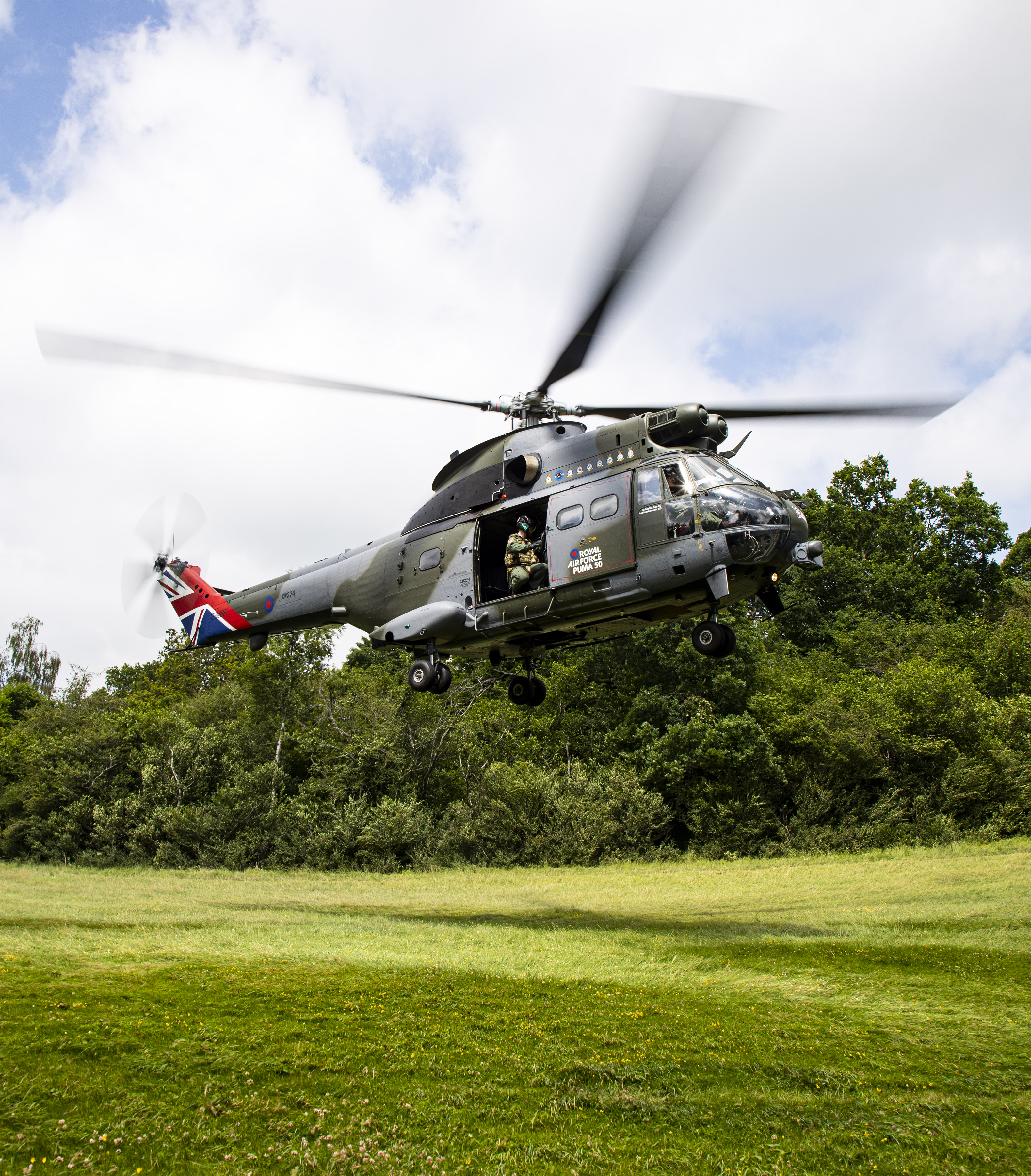 Wearing a 50th-anniversary special color scheme, a Puma HC2 flies over the Oxfordshire countryside in July 2021. Crown Copyright Hannah Smoker
Wearing a 50th-anniversary special color scheme, a Puma HC2 flies over the Oxfordshire countryside in July 2021. Crown Copyright Hannah SmokerAs for the bulk of the RAF Puma fleet, a replacement is still to be decided.
Last month, it was reported that the United Kingdom was “close” to deciding on a type for its New Medium Helicopter (NMH) requirement. This is the program to replace the Puma, but it’s been dogged by delays, cost concerns, and the withdrawal of two of the three bidding vendors.
Expected to be worth $1.5 billion, the NMH competition calls for up to 44 new rotorcraft, although, should the program survive, it’s likely to be trimmed down to 23–30 helicopters. As well as the Puma, the NMH is intended to replace the six shadowy ‘Blue Thunder’ AS365N3 Dauphin IIs that are used in support of special forces operations, notably by the Special Air Service (SAS).
Previously, the Airbus Helicopters H175M, Leonardo AW149, and Lockheed Martin S-70M Black Hawk were all in the running for NMH, but last year, both Airbus Helicopters and Lockheed Martin withdrew their participation. The companies said that they couldn’t fulfill the requirement within the budget provided. While it might be expected that Leonardo has now sealed the competition, there are still questions about whether it will survive, at least in its current form, amid a time of tough defense procurement decisions.

As for the retired Pumas, it’s also unclear what will happen to them.
While old, the airframes have been upgraded and well looked after and they could well be attractive on the secondhand market, provided they are not scrapped.
An alternative might be to donate them to Ukraine, which would surely find a use for them. Kyiv has also previously received helicopters retired by the U.K. Armed Forces, specifically former Royal Navy Sea Kings. Meanwhile, Portugal has also donated eight Pumas to Ukraine, so there would be some useful type commonality.
Whatever happens next to the ex-RAF Pumas, there’s no doubt that these venerable rotorcraft provided invaluable service to the British Armed Forces over a remarkably long period.
Contact the author: [email protected]

 By The War Zone | Created at 2025-04-01 00:33:01 | Updated at 2025-04-02 11:00:48
1 day ago
By The War Zone | Created at 2025-04-01 00:33:01 | Updated at 2025-04-02 11:00:48
1 day ago








